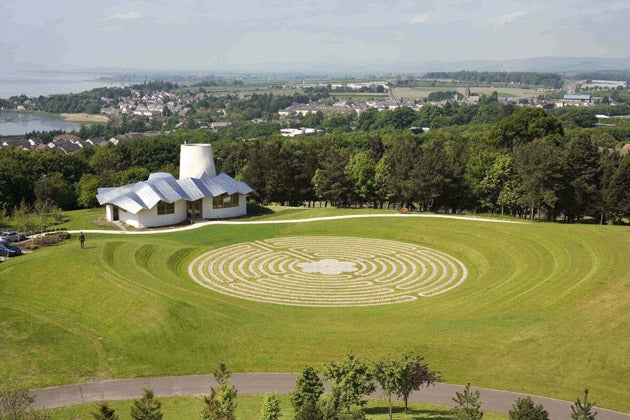Green serene: How the spectacular new grounds at a unique refuge ar helping cancer patients

Maggie's Centre in Dundee had the UK's first Frank Gehry building, and finally it has a spectacular garden to go with it. Gehry was commissioned almost a decade ago, and his folded metal roof sits atop a little white house. It looks almost like a gingerbread cottage sat on the side of the Firth of Tay, overlooking the water and the hills.
But this is no gingerbread cottage. Maggie's was started by Maggie Keswick Jencks, the architect and gardener. Told in 1993 that her breast cancer had returned and was now terminal, she set herself the task of calling in favours from friends and colleagues to create a centre that would sit alongside a cancer hospital to provide a warm welcome and a refuge from treatment, waiting times and the smell of disinfectant. Here, there are always fresh flowers, a bowl of fruit and, most importantly, someone to talk to. With no appointment necessary.
Maggie's first centre was in Edinburgh, but now there are six, with many more planned, and, where possible, the garden is a priority. At Dundee, Gehry's building was linked to the main oncology department by a dark, shady path through trees, and a helipad dominated the rather brutal view. Today, five-times Chelsea Flower Show gold-winner Arabella Lennox-Boyd has completely reshaped the space; like Gehry and many others, working for no fee.
The new garden pays tribute to traditional Scottish planting, with a bank of species rhododendrons (still sweet and small, with a just-planted air about them). There is also an outdoor room, though its walls are just a few feet high at the moment. But the most impressive feature is a set of turf banks enclosing a labyrinth. It's this maze, of cobbles and grass, that causes a ripple in the space here today.
On one side, a group of patients are waiting to see the Duchess of Cornwall, here to open the garden. Some have delayed their chemotherapy for an hour to watch events unfold; one even has binoculars. Across the labyrinth, they face the group of invited guests: the Lord Provost of Dundee, along with many of the fundraisers who made the landscape possible.
The press release makes reference to the medieval maze of repentance at Chartres, a model for Lennox-Boyd. But the lady with the binoculars, Sheena, who now volunteers at the Dundee centre, has her own interpretation: "As you walk into the labyrinth, you leave the outside world and your troubles behind. And as you walk, you gradually move towards the middle, centring yourself. When you arrive, you've found yourself again and you can walk out feeling more peaceful." Which is an apt description of the work of Maggie's itself.
For information: www.maggiescentres.org
Get centered: Landscapes that lull
Charles Jencks was Maggie's husband, and his gardens cut mathematical curves and geometrical forms into the landscape. See his landforms at the Scottish National Gallery of Modern Art, Edinburgh. Open daily, 10am-5pm. Free.
Westminster Abbey's cloisters and garden offer peace and quiet in the centre of London, while you try to imagine life in the 14th- century. The green square in the centre focused the mind while the monk made the circular walk around it. Free.
Longleat Maze has six elevated bridges from which to work out a strategy around it. Sixteen-thousand yew trees provide at least a mile's walk, and Google Maps makes solving mazes simpler – just print out an image before leaving home. £4 to enter, with another £3 to try the maze. Open daily till November
Subscribe to Independent Premium to bookmark this article
Want to bookmark your favourite articles and stories to read or reference later? Start your Independent Premium subscription today.

Join our commenting forum
Join thought-provoking conversations, follow other Independent readers and see their replies